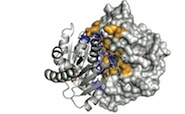Thursday 26 May 2016 4:51pm
Recent research from the laboratory of the Director, Professor Kurt Krause, has appeared on the cover of the Biochemical Journal. This work involved Professor Krause, Sinothai Poen, a recent PhD graduate, Yoshio Nakatani, Helen K Opel-Reading, Mortiz Lassé, Renwick D J Dobson and was titled "Exploring the Structure of Glutamate Racemase from Mycobacterium tuberculosis as a Template for Anti-mycobacterial Drug Discovery".
Glutamate racemase (MurI) is responsible for providing D-glutamate for peptidoglycan biosynthesis in bacteria and has been a favoured target in pharmaceutical drug design efforts. It has recently been proven to be essential in M. tuberculosis, a disease for which new medications are urgently needed. In this study, we have determined the protein crystal structures of MurI from both M. tuberculosis and M. smegmatis in complex with D-glutamate to 2.3 Å and 1.8 Å, respectively. These structures are conserved, but reveal differences in their active site architecture compared to that of other MurI structures. Furthermore, compounds designed to target other glutamate racemases have been screened and do not inhibit mycobacterial MurI, suggesting that a new drug design effort will be needed to develop inhibitors. A new type of MurI dimer arrangement has been observed in both structures, and this arrangement becomes the third biological dimer geometry for MurIfound to date. The mycobacterial MurIdimer is tightly associated with a KD in the nanomolar range. The enzyme binds D- and L-glutamate specifically, but is inactive in solution unless the dimer interface is mutated. We created triple mutants of this interface in the M. smegmatis glutamate racemase (D26R/R105A/G194R or E) that have appreciable activity (kcat = 0.056-0.160 min-1 and KM = 0.26-0.51 mM) and can be utilized to screen proposed antimicrobial candidates for inhibition.
Biochem J, 2016 vol. 473 (9) pp. 1267-1280.
The paper at the publisher's website.
